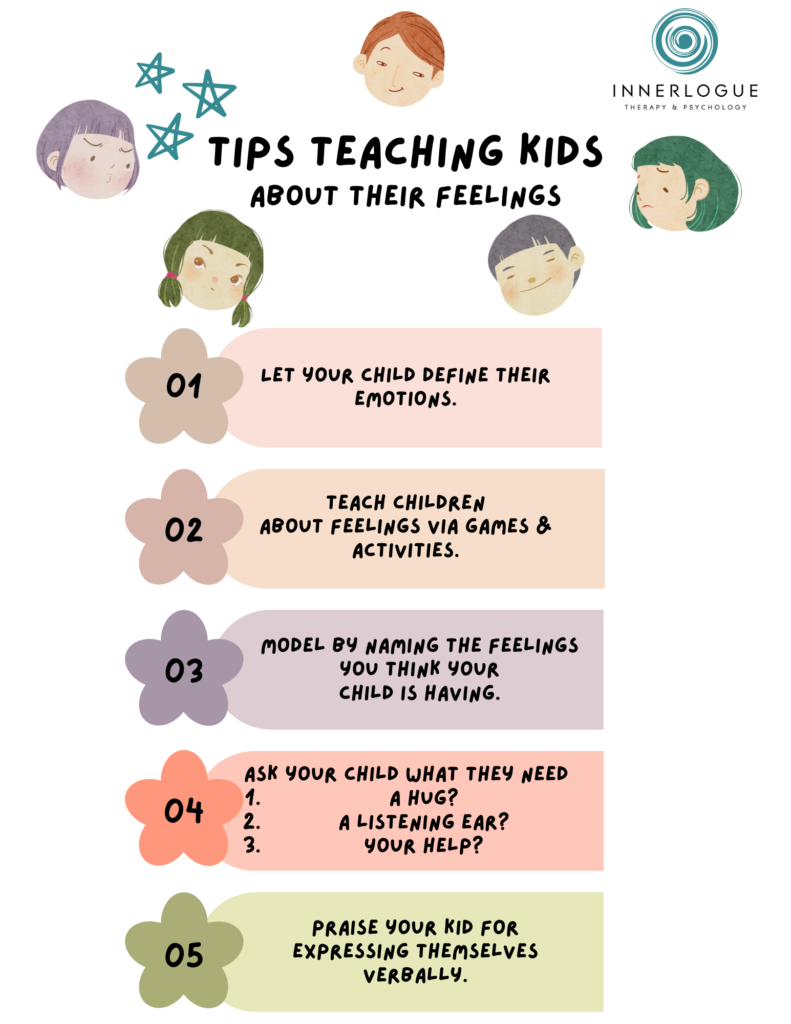Understanding and expressing emotions via feelings chart is a vital skill for children. It helps them navigate relationships, cope with challenges, and foster resilience. As parents and caregivers, we play a crucial role in guiding our kids through their emotional landscapes. In this blog post, we’ll explore five effective tips for teaching children about their feelings chart, along with a fun worksheet activity to help them express and understand their emotions better.

1. Let Your Child Define Their Emotions
Every child experiences emotions uniquely. Understanding a child’s specific needs, such as through a gifted assessment or IQ test, can help parents provide targeted guidance on emotional expression.Instead of imposing your interpretations, encourage your child to articulate how they feel. Ask open-ended questions like, “What does being sad feel like for you?” This not only empowers them to recognize and name their feelings chart but also fosters a sense of ownership over their emotional experiences.
2. Teach Children About Feelings via Games & Activities
Engaging kids through play can make learning about emotions enjoyable and children language development. Use games that involve role-playing or storytelling to illustrate different feelings charts, or explore CBT therapy approaches to integrate structured techniques for managing emotions.. Board games that incorporate emotional scenarios or apps designed for emotional literacy can also be effective. These activities help children associate emotions with experiences, making them more relatable and easier to understand.
3. Model By Naming the Feelings You Think Your Child is Having
Children learn by example, and consulting a Calgary psychologist can provide valuable insights into how parents can model and encourage emotional awareness. When you observe your child experiencing emotions, gently name them. For instance, if they seem frustrated while building a tower, you might say, “I see you’re feeling frustrated. It’s okay to feel that way.” This not only validates their emotions but also provides them with the vocabulary to express themselves in the future.
4. Ask Your Child What They Need
When children are upset, they often struggle to articulate their needs. Encourage them to express what they require in that moment. Ask questions like, “Do you need a hug?” or “Would you like to talk about what’s bothering you?” By guiding them to identify and communicate their needs, you’re teaching them to seek support when necessary.
5. Praise Your Kid for Expressing Themselves Verbally
Positive reinforcement can go a long way. When your child articulates their feelings, whether through words or art, acknowledge their efforts. Celebrate their courage to express emotions by saying things like, “I’m proud of you for telling me how you feel.” This encourages them to continue sharing their thoughts and feelings openly.
Emotional Mapping: A Fun Worksheet Activity/Feelings Chart
To reinforce these concepts, we’ve created a fun worksheet that helps kids map out their emotions on a scale from 1 to 10. This activity not only provides a visual representation of their feelings but also encourages discussions about fears and anxieties. By sitting down together and completing this exercise, you can guide your child through the process of identifying what they’re feeling and why.
How to Use the Ladder Worksheet
- Introduce the Ladder: Explain that this is a way to visualize their feelings. Each rung represents a different level of intensity—from feeling “calm” at 1 to “overwhelmed” at 10.
- Discuss Feelings: Ask your child to think about different situations that make them feel certain emotions. Encourage them to place those situations on the ladder according to how intense they feel.
- Share and Reflect: Take turns sharing feelings associated with each rung. This can lead to deeper conversations about why they feel certain ways and how they can cope with those emotions.
- Regular Check-Ins: Make this a regular activity to help them articulate their emotions over time. It can become a helpful routine that encourages ongoing emotional dialogue with Inner Logue Therapy.
Great job!
Teaching children about their feelings chart is an invaluable investment in their emotional intelligence. By using these five tips and incorporating interactive activities like the ladder worksheet, you’re equipping your child with the skills they need to understand and express their emotions healthily. As they grow, these tools will help them build strong relationships and navigate life’s challenges with confidence. Remember, fostering emotional awareness in children is a journey—one that will serve them well throughout their lives.
For adults reading this post and wondering how we can also tune in to our emotions, a popular way of doing that is by journaling.
FAQs
1. What is a Children’s Feelings Chart?
A Children’s Feelings Chart is a visual tool that uses pictures, words, or emojis to represent different emotions. It helps children identify and articulate their feelings in an accessible way.
2. How can a Children’s Feelings Chart help children express their emotions?
It provides a simple, non-verbal way for children to label and share their emotions, improving emotional awareness, communication skills, and helping them feel understood.
3. How do I introduce a Children’s Feelings Chart to my child?
Start by explaining how it works, use examples from their daily life, and demonstrate how to select feelings on the chart. Encourage its use during regular conversations or emotional moments.
4. Can a Children’s Feelings Chart be used to identify behavioral issues?
Yes, tracking recurring emotions on the chart can reveal patterns or triggers for behavioral issues, helping caregivers address underlying causes more effectively.
5. Can a Children’s Feelings Chart be helpful in reducing tantrums or emotional outbursts?
Absolutely. The chart helps children recognize and express feelings before they escalate, fostering emotional regulation and reducing the frequency or intensity of tantrums.




